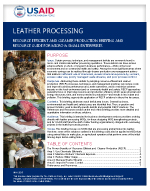Certain process, technique, and management deficits are commonly found in micro- and small-scale leather processing operations. These deficits can have serious adverse effects on short- or long-term business performance---AND, on the local environment and on community health and safety. Among the most significant areas where economic savings can be realized through cleaner production are management actions that address inefficient use of chemicals, excess chemical exposure by workers, excess water use, poorly managed waste streams, and poor process control.
Addressing these deficits by adopting resource-efficient and cleaner production (RECP) processes, techniques, and management practices can reduce costs and improve business performance and, at the same time, avoid or minimize adverse impacts on the local environment and on community health and safety. RECP approaches generally focus on improving resource and production efficiency which saves physical and energy resources, time, and money needed in production—and results in less waste and pollution. This briefing supports the application of RECP solutions in these five key areas.
Resources
References
- Marks and Spencer, CP Module 3a: Minimum Standards and Best Practices for tannery. Version 1.0 (2013). http://corporate.marksandspencer.com/documents/how_we_do_business/ecp3a.pdf.
- Policy Options to Address Informal Sector Contamination in Urban Latin America: The Case of Leather Tanneries in Bogotá, Colombia. LATEN Dissemination Note # 14 (1995). Biller, Dan and Quintero, Juan David.: World Bank.
- Covington, Anthony D. (1999). Innovations in Processing. International Union of Leather Technologists and Chemists Societies (IULTCS) Congress held in Chennai, India, January 1999. http://leather.webindia.com/innovation.html.
- Hair-Save Unhairing Methods in Leather Processing (2000). Regional Programme for Pollution Control in the Tanning Industry in South-East Asia, United Nations Industrial Development Organization (UNIDO). http://www.unido.org/fileadmin/import/userfiles/puffk/l_hairsave_unhairing.pdf.
- Re-Use of Chromium in Leather Tanning. United Nations Environment Program (UNEP) Cleaner Production Case Studies. http://www.p2pays.org/ref/10/09545.htm.
- EP3-Pollution Prevention Audit for a Sheep Hide Tannery. United Nations Environment Program (UNEP) Cleaner Production Case Studies. http://www.p2pays.org/ref/10/09234.htm.
- EP3-Cleaner Production Audit for a Cattle Hide Tannery. United Nations Environment Program (UNEP) Cleaner Production Case Studies. http://www.p2pays.org/ref/10/09238.htm.
- Three short case studies of cleaner production in a medium-scale sheep and cattle hide tanneries. These provide a useful overview of cleaner production opportunities. Included are cost estimates of cleaner production methods. The studies also focus on re-use of chemical effluents.
- Food and Agricultural Industry (1997). United States Environmental Protection Agency (EPA). http://www.epa.gov/ttnchie1/ap42/ch09/final/c9s15.pdf.
- Leather Tanning and Finishing Waste Management Research and Development Program (1976). United States Environmental Protection Agency (EPA). http://nepis.epa.gov/Exe/ZyPURL.cgi?Dockey=9101BG3W.txt.
- Sahasranaman, A. (1999). Occupational Safety and Health in the Tanning Industry: Emerging Challenges. International Union of Leather Technologists and Chemists Societies (IULTCS) Congress held in Chennai, India, January 1999. http://leather.webindia.com/safety.html.
- Sources, Detection and Avoidance of Hexavalent Chromium in Leather and Leather Products (2000). Regional Programme for Pollution Control in the Tanning Industry in South-East Asia, United Nations Industrial Development Organization (UNIDO). http://www.unido.org/fileadmin/import/userfiles/puffk/hexavalent.pdf.
- "Tanning and Leather Finishing" (1998). In Pollution Prevention and Abatement Handbook. Washington, D.C.: World Bank. http://www1.ifc.org/wps/wcm/connect/7d72fb00488553bab04cf26a6515bb18/tanning_PPAH.pdf?MOD=AJPERES&CACHEID=7d72fb00
488553bab04cf26a6515bb18.
This module explains the Marks & Spencer minimum standards and best practices for tanneries.
This report is a case study of informal leather tanneries in the San Benito neighborhood of Bogotá, Colombia. It includes proposals and policy options for addressing the industry's pollution problems.
This paper includes a useful overview of hide processing and presents new or alternative production methods that increase efficiency and/or reduce chemical use.
This report discusses methods of unhairing that result in lower levels of contaminated wastewater, compared to traditional chemical unhairing procedures.
The linked chapter on tanning has a good overview of the tanning process and an intuitive process flow diagram.
A quantitative resource on initial steps to take to control pollution (most especially biological oxygen demand and chromium in wastewater).
This short report lists worker safety issues associated with tanneries and provides policy strategies for addressing these issues.
This document evaluates a variety of tanning production methods to see which produce dangerous levels of chromium IV, a by-product of chromium III usage. Technical in some sections, but the general discussion on which methods produce the most danger is quite accessible.
This chapter from the World Bank's pollution prevention handbook provides minimum pollution standards for tanneries and leather finishers.
Other Resources:
- Money, Catherine A. Curing of Hides and Skins: Alternative Methods. Australia: CSIRO Leather Research Centre. http://www.csiro.au/files/files/pez8.pdf.
- Pojer, Peter M. and Chi P. Huynh (2009). A Salt-Free Pickling Regime for Hides and Skins. Australia: CSIRO Leather Research Centre. http://www.scribd.com/doc/95760042/A-Salt-free-Pickling-Regime.
- Tanneries and the Environment: A Technical Guide to Reducing the Environmental Impact of Tannery Operations (1991). Technical Report Series No. 4. United Nations Environment Program (UNEP)..
These two papers present alternative methods of hide preparation and unhairing. There is a short discussion of current methods and alternative methods that can improve quality.
Provides information on eliminating the salt pickle method of preparing hides for tanning.
Extensive discussion of environmental issues associated with tanneries, with possible solutions.
